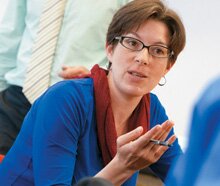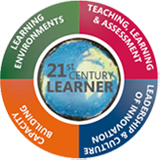Innovation Framework

A system for guiding school reform
It has long been understood that education is central to the development of individuals and to creating socioeconomic opportunities in communities around the world. Yet many nations find that their current educational systems are not engaging students or preparing them for the future.
Sparking the natural curiosity of young people and enabling them to be successful in the workplace often involves changing an entire education system, rather than just tinkering with its parts. Systems, whether biological, political or organizational, are comprised of interconnected sets of sub-systems. Changing just one or two parts of a system may be helpful, or it might be harmful or have no discernable effects, depending on how the change interacts with other aspects of the system.
VIDEO: Innovation in education
 PLAY
PLAY
Similarly, transforming education is traditionally challenging, and there is often a discrepancy between policymaking and true change in the student learning experience. We live in a time of constant technological change and innovation, which affects nearly every aspect of our lives — from the way we communicate to how we do our jobs and spend our leisure time. Yet in the world of education, comparatively little has changed.
Classrooms across the world look much as they always have, with a single teacher in front of a blackboard imparting lessons to students seated at rows of desks. The school day is divided into periods that correspond to specific subjects in a fixed curriculum. Within this traditional model, some schools might add in a bit of technology as a way to increase efficiency or access to information.

Expectations are changing
Outside school, young people all over the world browse the web, download music, visit chat sites, upload homemade videos, communicate with friends using instant messaging, watch multi-channel digital TV, blog about their experiences and read books, magazines and articles online. Much of this activity happens simultaneously and on portable devices. In this increasingly interconnected world, young people have an expectation that experiences, services and products can be configured to their individual needs and preferences.
A complex problem
The challenge for education in the 21st Century is to create an approach that is agile, adaptable and in tune with young people's lives outside of the classroom and their future employability. The answer lies in innovation, but the question is what kind of innovation, and how should it be implemented?
The solution is complicated, and using technology as the only solution will not solve these challenges. Even when introduced in schools with the necessary physical infrastructure, simply giving each child a computer will typically not produce superior learning without additional changes in the nature of the school's teaching, learning and assessment practices. In this example, effective change would require a more holistic approach to completely transform the learning experience of the learners.
A systematic approach to reform
Below the surface of successful schools is a system of connections and interrelationships that enable transformation in a focused and coordinated way. A helpful framework for thinking about systems innovation is adapted from the work of Knapp, Copland and Talbert. The goal of the framework is to help coordinate changes so that they complement rather than compete with one another. The framework highlights four top dimensions in successful transformation. These dimensions are critical success factors individually but more effective when connected with each other.

Major areas of reform
-
Teaching, learning and assessment
The Innovation Framework highlights four areas related to what and how students learn:
-
21st Century Skills and standards
-
Curriculum and the learning paradigm
-
Assessment
-
Innovative uses of ICT
How should a curriculum be designed, and how should students be assessed?
In most countries, school curricula and instruction are mostly didactic based on subject-based knowledge transmission and large amounts of rote learning. This ignores many skills that are increasingly necessary for life and work and often fails to engage students. Of course, schools implement and work according to national standards and other learning requirements, but they can also consider more effective teaching and learning strategies and encourage studentcentered learning and assessment processes.
How can student-directed learning be encouraged?
Many innovative schools actively engage students in their learning and in the co-design of the learning process. There are a variety of ways of doing this, from the use of student councils to students as researchers within schools, to online student feedback on the quality of teaching and lea rning. Technology skills are crucial in the 21st Century skill set, but technology should play a bigger role in the transformation of learning practices. High-level ICT integration increases the possibility of personalizing learning processes, making learning accessible to students anytime and anywhere.
-
-
Leadership and culture of innovation
A second area for reform relates to developing, sustaining, and scaling school improvements. The elements highlighted in this area, include:
-
Innovation culture
-
Leadership development
-
Learning community
-
Innovative uses of ICT
How can the school develop a culture that is conducive to innovation?
At the heart of the innovative process is a school culture that is dynamic, forward-looking and empowered. In Michael Fullan's book, The Six Secrets of Change5, one of the elements of successful change is understanding that learning is the work. As he says, "Learning is not workshops and courses and strategic retreats. It is not school improvement plans or individual leadership development. These are inputs. Rather, learning is developing the organization, day after day, within the culture."
An innovative school is not one person's creation but rather the product of enabling the whole school to help design new processes and procedures. This requires successful management of relationships at all levels across the school and beyond to include parents, community, and other stakeholders. A particular focus is on leadership development, preparing administrators to be instructional leaders, supporting a distributed group of leaders rather than a select few, and devising plans for developing leaders and leadership skills at all levels. These leaders are responsible for promoting a school-wide learning community that keeps all stakeholders working together on the common goal of improving student learning.
In addition to the development of individuals, a culture of innovation depends on organizational development and management. Another way to facilitate innovation is changing school structures such as facilities, programs and use of time. Finally, providing time during the school day for staff collaboration and school networking can enable effective change.
How can a school measure its success? What system of metrics should it employ? How does the management of a school relate to its ability to implement innovative practices?
Continuous evaluation is necessary for developing and sustaining a culture of innovation. Successful innovation requires that schools use technology-based analytical tools that help them measure student outcomes and identify those who are struggling academically and their areas of underperformance. By using such systems, educators can more effectively deploy resources and intervene at appropriate points. At school level, measures of progress can range from student attitudes and achievement to overall school metrics to attendance and drop out rates.
-
-
Capacity building
Another area for reform focuses on how teachers learn and teach. This area highlights four elements:
-
Professional practices and standards
-
Peer coaching and mentoring
-
Professional development
-
Innovative uses of ICT
How can teacher skills be identified, taught and measured? What kinds of training and development are needed, and how can their effects be measured?
Just as student learning must evolve beyond a transmission model to actively engage students, teacher-learning means more than attending required workshops and teaching in isolated classrooms. Experts agree that true professional development involves establishment of a professional community focused on learning. In an environment where the expectation is continuous learning through supportive feedback, teachers can develop and practice the 21st century skills they want students to develop. At the heart of these are social skills and the development of measurements to assess their use.
Teachers need continuous training and supportive assessment to cope with the demands of the changing educational landscape. One route is for schools to develop their own models for training and apply these consistently. Professional development includes peer-to-peer coaching and mentoring not only for newly hired teachers, but as ongoing practice for all teachers. As with other areas of reform, technologies offer opportunities to transform teaching and the support of teacher learning.
-
-
Learning environment
A fourth area for reform on the Innovation Framework focuses on where and when students learn. This area includes several dimensions:
-
Physical and virtual environments
-
Formal and informal environments
-
Innovative uses of ICT
One dimension to consider is the design of physical spaces for rich and diverse educational experiences, including space for oral discussion, project work (creations in art, science, etc.) and performance. Learning opportunities can be extended by considering virtual spaces for simulations, role-playing and networking.
The learning environment can be developed so that it supports learning in and out of school through such options as community service and workplace internships, and by involving community members as mentors and coaches. In this way, education is unconstrained by time and place.
How can the school use technology for management, learning and communication? Can the school personalize its offerings and measure outcomes using technology?
As with all areas of reform, technologies are key to transforming the learning environment. Too often technology is "bolted on" and not integral to enhancing and assessing learning within schools. Schools need access to technology for all students and teachers in order to support anytime anywhere learning, personalization and 21st Century skills.
-
Reflecting on the innovation framework
The Innovation Framework provides a starting point for schools initiating the process of reform, and for others already on their reform journey it can serve as a reminder of the many options available to sustain an ongoing process of school innovation. Here are some questions a school team could reflect on as they think about the Innovation Framework:
- Are we settling for incremental improvements when we could be introducing innovation that will fundamentally transform learning?
- Are we targeting change in too few or too many areas?
- In what areas are there barriers to changes that we think are important to make? How can we innovate to overcome those barriers?
- How are we connecting student, professional and system learning with one another and with learning goals to create coherence in our reform efforts?
- How are we targeting change across all the relevant settings: our school, school system and community, and state or national levels?
- How can we use technologies to support our innovation?
- How will we know if we are successful? How do we measure, assess and use feedback? What system of metrics will we use?
Microsoft's Partners in Learning Innovative Schools program is an initiative that is helping schools around the world move beyond the limits of traditional classroom and learning models. Working with pathfinder schools for innovative thinking and best practices, the Innovative Schools program is creating models that any school or system can use to prepare children for success.
A DIFFERENT APPROACH
Many innovative attempts to introduce student-centered, problem-based learning and technology-rich learning environments have not succeeded because they collided with existing — and sometimes outdated assessment practices, or because professional development for teachers and leaders was underemphasized.
Using the Framework helps innovators think through each of the pieces of reform and how they interrelate.
HELPFUL RESOURCES
Innovation Framework Workflow 202k pdf
Creating Innovative Schools 1039k pdf
Creating Innovative Schools 1039k pdf
Self-reflection Tool This tool helps to break up the process of innovation into four key areas in any school and allows you to explore each area and how it benefits your school.


